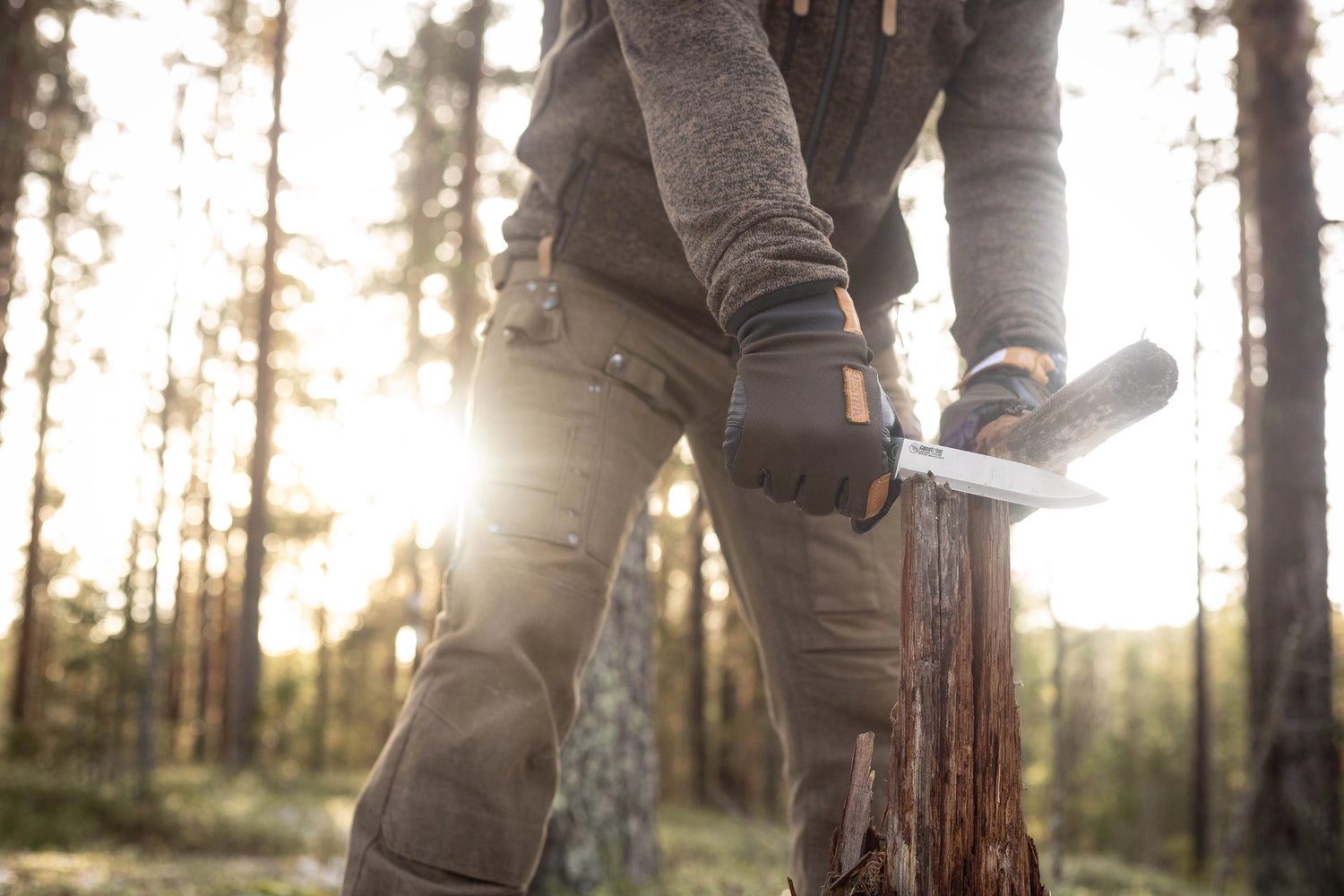Batoning wood is a core bushcraft skill—splitting firewood using a fixed-blade knife instead of an axe. It’s not just brute force; it’s a mix of technique, safety, and choosing the right bushcraft knife for the job.
In this guide, we explore how to split wood safely and efficiently, and we compare the Casström knife steels for batoning: A8 Mod, Sleipner, and 14C28N. We also assess different grind types and how suitable they are for batoning.
Understanding Wood: Knots, Grain, and Hardness
Before you start swinging that baton, assess your wood. There are a few things to look at before you set your blade against the piece of wood you want to split.
Knots & Grain Direction:
Avoid pieces with heavy knots—these can deflect the blade or cause chipping. Avoid wood near the root or other sections with very wavy or curving grain - these will more easily cause jamming. Batoning the wood along the grain is ideal for a cleaner, easier and safer split.
Hardwood vs. Softwood:
Hardwoods (e.g., oak, birch) are denser and more difficult to split, but they burn longer.
Softwoods (e.g., pine, spruce) are easier to baton and great for quick fire-starting.
Green vs. Seasoned Wood:
Green wood is high in moisture and difficult to split.
Dry or dead wood batoning is easier, and it’s ideal for firelighting.
Log size:
The length of your knife and the wood characteristics determine what size log you can handle. Choose logs no thicker than your blade length minus 2.5 cm (one inch). This ensures you have enough exposed blade to strike safely. Dry, straight-grained softwoods may allow for splitting of wider logs with a single strike.

Safety First: Proper Technique for Batoning Wood
When using a bushcraft knife for batoning, technique and safety are paramount:
Knife Placement
Position the blade vertically across the piece of wood, ensuring it is parallel with the grain.
Strike the Spine, Not the Handle and Avoid the Tip
Use a solid wooden baton (a thick branch works well) to strike the spine of the knife.
Don’t hit the handle since the scales may be affected, especially if made from wood.
Avoid hitting the tip—it’s the weakest point and may break. This is especially important on a knife with a full flat grind.
Stabilize the Log
Place the wood on a firm, level surface, like a stump or flat rock. Avoid soft or uneven ground, which can destabilize your batoning stroke.
Controlled Force
Use firm, controlled strikes. Excessive force may drive the blade through the log and into the ground or stone, potentially damaging the edge. If the blade sticks, gently tap from below and wiggle it side to side to free it.
Casström Knives: Steel Comparison for Batoning
The batoning process is rough on a steel edge and a good steel is therefore crucial to ensure the knife functions well for the job. Steel features that impact suitability for batoning:
- Toughness – the most important aspect which prevents the blade from snapping and the edge from chipping.
- Wear resistance – decent wear resistance is important to ensure the edge doesn’t dull quickly rendering the knife useless for other tasks.
- Ease of sharpening in the field – the edge will need renovating when used repeatedly for batoning and the ease of re-sharpening is therefore beneficial.
This is how the steels Casström use compare on these parameters:

15N20 Steel – Toughness with a wicked edge
Nickel alloyed high carbon tool steel that takes a very sharp edge and is super tough.
- Toughness: Exceptional
- Edge Retention: Good
- Ease of Sharpening: Exceptional
Ideal for heavy-duty batoning and survival tasks. Handles knotty, seasoned hardwoods with ease; resists edge chipping and spine stress. Very easy to sharpen which is great if you use the knife for tough jobs. Not stainless, therefore less ideal for wet environments.

A8 Mod Steel – Toughness with an edge
Alloyed tool steel built for impact.
- Toughness: Exceptional
- Wear resistance: Good (With Cryo Quench)
- Ease of sharpening: Very Good
Superb for heavy-duty batoning and wood carving. Handles knotty, seasoned hardwoods with ease; resists edge chipping and spine stress. Easy to sharpen. Not stainless, therefore less ideal for wet environments.

14C28N Steel – Tough and Stainless
Martensitic stainless steel with nitrogen,
- Toughness: Very high
- Edge Retention: Good (with Cryo Quench)
- Ease of Sharpening: High
Great for batoning, food prep, wet environments. Slices and carves well. Sharpens easily for a stainless steel.

Sleipner Steel – An edge with toughness
Alloyed tool steel that balances wear-resistance and toughness with high hardness.
- Toughness: Good
- Edge Retention: High
- Ease of Sharpening: Good
Great for all-purpose bushcraft, with occasional batoning. Great for wood carving, processing game with a Great balance of strength and edge retention. Less prone to rust than simpler carbon steels.

Which knife grind is most suitable for batoning?
The grind type is one of the most important aspects for effective batoning and it greatly affects the durability of the knife. The ideal grind for batoning will have the following features:
- Wood Splitting Performance – the edge angle and thickness suitable and sharpness allowing the blade to first penetrate the wood, then to force the wood apart with the shoulders of the blade without getting stuck
- Impact resistance – resistance to cracking if wedged and chipping if hitting hard knots or other hard materials.
- Ease of sharpening in the field - the edge will need renovating when used repeatedly for batoning and the ease of re-sharpening is therefore beneficial.
How different grinds perform for batoning:
Scandi grind
We will assume the angle is around 30 degrees and the steel used is at least 3mm thick.
- Wood Splitting performance: Exceptional – digs in easily, gets the shoulders engaged quickly to drive the wood apart.
- Impact resistance: Very Good – since the blade has full thickness until it hits the short grind it resists severe cracking extremely well.
- Ease of sharpening in the field: Very good – the entire bevel can be sharpened on a flat stone which makes maintaining the correct angle throughout the process very simple.
Scandinavian grind knives are great for batoning, and also does well for wood carving and game processing. A small secondary microbevel can be added to the scandi grind with a lower angle than the typical 28-30 degrees or if you just want added durability to a typical angle.
Convex Grind
We will assume a blade thickness of at least 3mm, a grind around 35 degrees and normal knife steel at around 58-60 Rockwell hardness.
- Wood Splitting performance: Exceptional – digs in easily, gets the shoulders engaged quickly to drive the wood apart.
- Impact resistance: Very Good – since the blade has full thickness for the majority of the width it resists severe cracking extremely well. The geometry protects the edge well.
- Ease of sharpening in the field: Low – this grind requires skill to re-sharpen well in the field. Easy to end up increasing the angle and ruining the knife’s cutting/carving ability.
Convex grind knives are great for splitting, works for carving, but when the edge goes then this grind is more challenging to restore in the field. A convex grind is the standard grind for axes, but unlike survival knives they are typically made from softer steel making them easier to re-sharpen. Also, axes don’t need the same cutting ability so re-sharpening accuracy is less essential.
Full Flat Grind
We will assume at least 3,5 mm thickness, edge angle between 30-40 degrees. Thinner Full Flat Grind knives are not suitable for batoning.
- Wood Splitting performance: Medium – digs in easily but can struggle to engage shoulders unless it has a very thick spine. Gets stuck more easily than the other two grinds.
- Impact resistance: Medium – since the blade gets gradually thicker it can attract some severe cracking if jammed badly. This depends mainly on the thickness behind the edge.
- Ease of sharpening in the field: Medium – this grind requires some skill to re-sharpen in the field but if done correctly can be done fast since less material needs to be removed compared to a scandi or convex grind.
Flat grind knives cut very well but they are not ideal for batoning wood. Splitting some kindling to start a fire is usually not an issue but material selection and good technique is more important with this type of grind.

4 Batoning Tips for Success
- Choose the Right Log Size: Select wood that’s around 2,5cm (1 inch) smaller in diameter than your blade length to avoid binding or jamming.
- Don’t Use Rocks: Never strike your knife with a stone—this can damage even the toughest steel.
- Secure Grip: Casström’s curly birch and micarta handles offer excellent traction, even with gloved or wet hands.
- Full-Tang Construction: Always baton with a full tang knife for maximum strength and safety.
Final Thoughts: The Right Knife for the Right Job
Whether processing firewood or building a shelter, batoning is a vital bushcraft skill. Casström knives offer steels to match your needs:
- 15N20 ideal splitter
- A8 Mod for rugged durability
- Sleipner for balanced versatility
- 14C28N for corrosion resistance and easy maintenance
Choose your steel in combination with a Scandi grind, refine your technique, and enjoy the confidence that comes from knowing your gear can handle the challenge.
Happy batoning!
Ready to try it for yourself? Explore Casström’s full range of bushcraft knives today.

